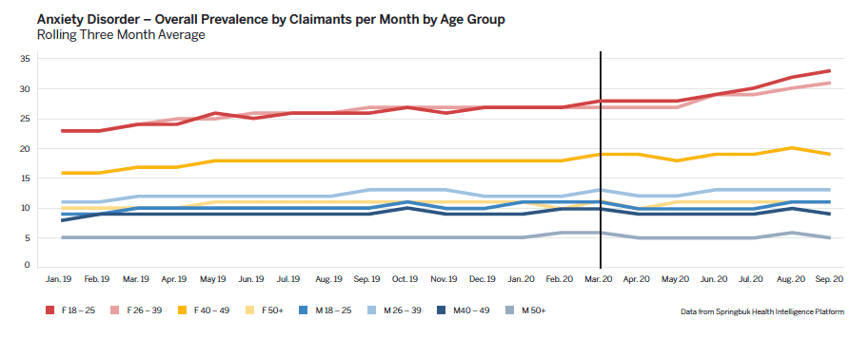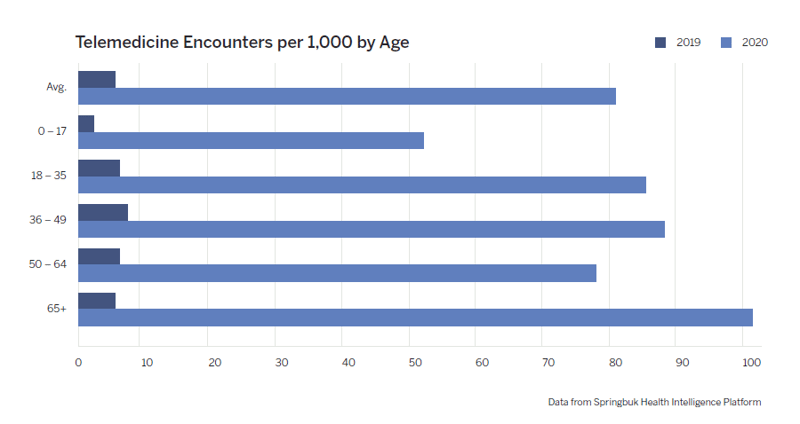
Regardless of your industry, COVID has clearly taken a toll on employee well-being. In a recent study, the Kaiser Family Foundation found that more than 1 in 3 U.S. adults struggle with pandemic-related anxiety and depression. A WebMD study also reported that the pandemic has had a negative impact on 77% of the employee respondents’ well-being.
How else has the stress and strain of the pandemic affected your staff and their health care needs? And more importantly, what can your organization do to help?
Employee Well-Being Trends—and Takeaways—for a New Era
As it turns out, your employees desperately want you to help them. The same WebMD study found that employees feel strongly that they should be supported by their employers, with 70% of employee respondents identifying the need for access to coaches and other services to cope with anxiety, depression, and stress.
Fortunately, this cry for help is at least being noticed: In the HR Research Institute State of Employee Health and Well-being 2021 report, 83% of corporate leaders consider employee mental health one of their top five HR priorities.
That’s only one example of how significantly the role of workplace wellness has shifted. For the full picture, we turned to our friends at Springbuk, whose 2021 Employer Health Trends Report revealed a number of significant data points that highlight why companies need to create or adjust their workplace wellness programs to address employee well-being.
Don’t Be Fooled by the Numbers
If you didn’t initially see an uptick in depression or anxiety diagnoses through your employee health care program, you’re not alone. But that lag shouldn’t make any company believe there isn’t a real concern.
Springbuk analysts didn't see remarkable trends or a huge uptick in diagnoses either, but that’s likely due to so many people seeking care for themselves from third-party vendors instead of medical practitioners through their health plans. The stigma of a depression or anxiety diagnosis is a much more plausible explanation, according to Jennifer Jones, Senior Director of Health Strategy at Springbuk.
Whether employers have seen the number of diagnoses increase or not, “we do know that acute depression, anxiety, and stress are higher now than they were this time last year,” says Jones.
Employee Well-Being Program Takeaway: Provide access to therapy and coaching in ways that lessen the stigma and make employees feel more at ease.
Women Are Especially Vulnerable
In both the Springbuk study and the WebMD study referenced earlier, researchers found that women were being treated for anxiety and depression more often than men—specifically, women in the 18 to 39 range. Despite the fact that both men and women worked from home during the pandemic, women continued to shoulder the majority of caregiving duties, making that burden even greater.

“Prior to the pandemic, over 40% more women were diagnosed or treated for some type of mental health or substance abuse condition,” highlights Jones. “That jumped up to over 50% more during the pandemic.”
The good news, she adds, is that it signals a lessening in the barrier to mental health care for women, especially, when they can connect with a coach or counselor over the phone or via text.
The not-so-good news? Women’s financial wellness was impacted with layoffs in industries predominantly staffed by females, such as service and hospitality.
"Prior to the pandemic, over 40% more women were diagnosed or treated for some type of mental health or substance abuse condition. That jumped up to over 50% more during the pandemic."
−Jennifer Jones, Senior Director of Health Strategy at Springbuk
Employee Well-Being Program Takeaway: Look at how your organization can create caregiving programs, offer more parental leave, and provide financial wellness education targeted to women.
Employee Well-Being Applies to the Whole Family
With employees working from home for over a year—and many continuing beyond that—companies need to be aware that the well-being of their employees includes that of their spouses and families as well.
In the Springbuk report, the top four mental health conditions reported for adults were anxiety disorders, adjustment disorders (up 14% from the previous year), depression, and alcohol and substance abuse disorders. For children, the top four were similar, except alcohol and substance abuse is replaced with attention-deficit and conduct disorders.
Many of your employees have spent the last year working from home while trying to help their children with ADHD or some other related condition that has been exacerbated by the isolation and frustration of online school. It’s no surprise that employees are struggling to focus and manage stress levels. You’ll need to rise above the noise of work projects and home life to make sure your employees are taking advantage of the programs you offer.
Jones suggests intentionally overcommunicating. Utilize every channel possible to let employees know about wellness programming available to them to support work life balance, stress levels, physical health, and mental health benefits.
Employee Well-Being Program Takeaway: Make sure employees know that they can jump on a Zoom or send a text to take advantage of wellness coaching and the other challenges and programs you offer.
Employers Can Take Advantage of Telehealth Benefits
Speaking of Zoom and texting to access care, the pandemic significantly changed how employees receive care both out of necessity and convenience. Springbuk reports that telehealth usage increased twelve-fold between 2019 and 2020 and is continuing to increase in 2021—most predominantly in mental health care. “We were seeing just over 44% of total telemedicine claims coming from mental health,” says Jones. “In years prior, it was traditionally for acute illnesses.”
 This is great news for encouraging employees to take advantage of employee well-being programs and mental health benefits. “Over 50% of people said they liked the visits via telemedicine and would like to continue that in some capacity,” says Jones. “So there's definitely a genuine interest in it.”
This is great news for encouraging employees to take advantage of employee well-being programs and mental health benefits. “Over 50% of people said they liked the visits via telemedicine and would like to continue that in some capacity,” says Jones. “So there's definitely a genuine interest in it.”
Moving forward, innovation around telemedicine and new legislation pertaining to reimbursement rates will expand telehealth to make it even easier to see a physician when needed.
This means your employees will be getting the care they need instead of taking time off to see the doctor, or worse–delaying care and potentially having to miss multiple days of work due to illness and disability.
Provide Employee Education on Telehealth
Helping your employees understand how to best use telehealth will not only make the health care ecosystem work more efficiently, it will also make them more informed and empowered health care consumers (which means less stress). Make sure your employees understand how they can take advantage of telehealth, especially with COVID still being a concern.
Emergency Room Prescreening
Employees can utilize telehealth services at their local ER before heading to the hospital. Most urgent care clinics have a hotline, a chatbot, or even a telehealth option where a nurse or other medical practitioner can conduct a basic screening.
Employees may save a trip to the ER and see their physician the next day, or they may take advantage of telehealth services with their physician to address their issue. From a health plan cost and utilization perspective, this type of prescreening presents a win-win for your company and your employees.
Remote Monitoring
Remote monitoring services for blood pressure and other biometrics are becoming more widely available. This can significantly help employees at risk for heart disease, stroke, diabetes, and other serious conditions stay on top of their health care and improve their numbers.
Employee Well-Being Program Takeaway: Add a telehealth section to your workplace wellness program knowledgebase for employees to access.
Communicate Telehealth Benefits to Employees
Most carriers have some type of telehealth component built into their existing health plan and it’s often provided at a lower copay and lower cost than in-person care. Employers simply need to make sure their employees are aware of the telehealth benefits available to them.
One great way to communicate these benefits is by allowing employees who have used them to share their stories. Provide employees feedback from their peers who have had good experiences that saved them time and money.
Employee Well-Being Program Takeaway: Create a “telehealth success story” campaign that highlights the benefits of telehealth to employees. For extra credit, create a wellness challenge around utilizing telehealth over in-person health care when appropriate.
The pandemic has completely changed the landscape for employees, whether they work from home or back in the office. The mental health impacts continue to be pervasive and must be addressed by your workplace wellness program to promote employee well-being. With the steady adoption of telehealth as a way to help employees and companies save time and money in seeking health care, these services need to be included as part of any future wellness program.
WellRight has been working with employers throughout the pandemic to help them adjust to the needs of employees. For assistance in adapting the takeaways in this blog into your workplace wellness program, we’re here to help.




